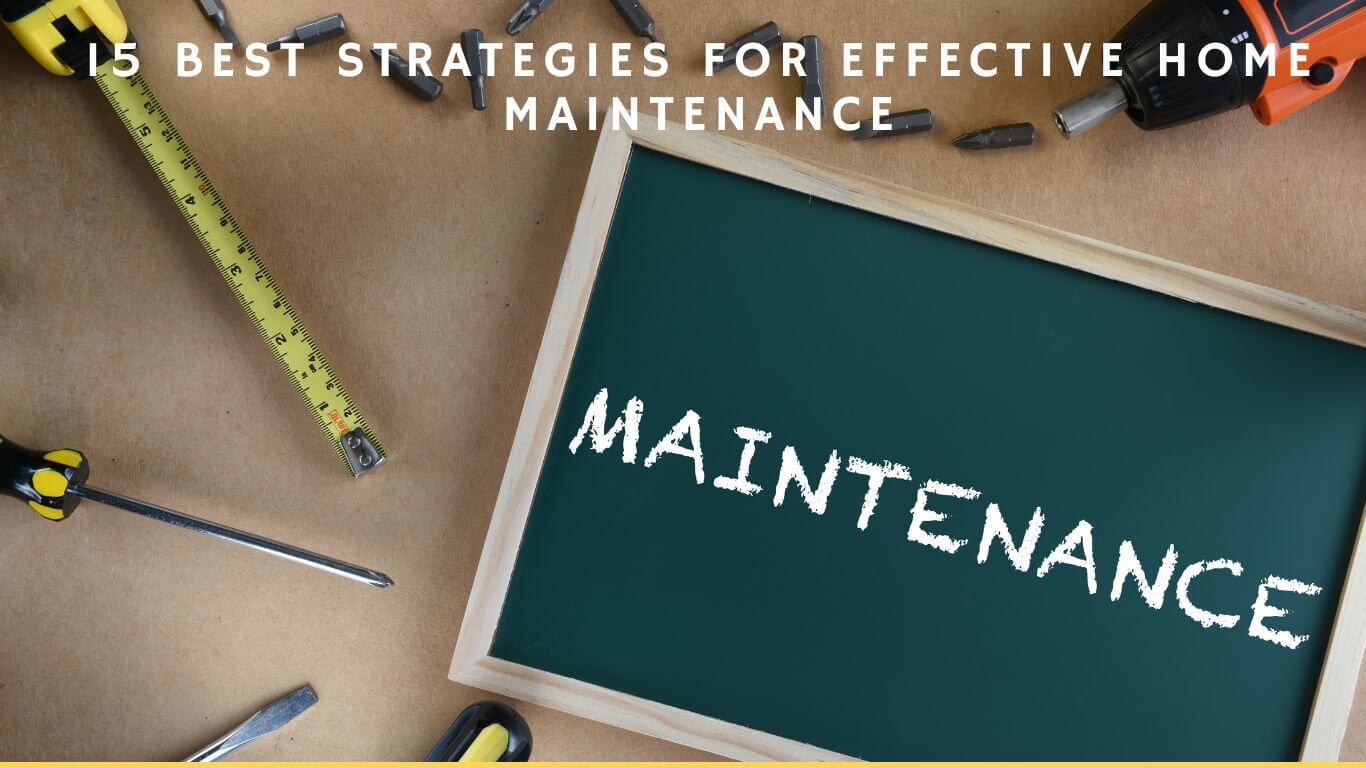Keeping your home in top shape is essential for its longevity, comfort, and value. However, effective home maintenance requires more than just occasional cleaning and repairs. It involves implementing strategic strategies to address various aspects of your home’s upkeep.
In this article, we will discuss the best strategies for effective home maintenance, ranging from regular inspections and routine cleaning to proactive measures and preventive maintenance.
By incorporating these strategies into your maintenance routine, you can save time, money, and stress while preserving the beauty and functionality of your home for years to come.

Regular Cleaning and Organizing
To maintain an organized and clean home, you need to consistently prioritize tidying up and decluttering. Regular cleaning and organizing are essential for creating a space that promotes a sense of belonging and comfort. Here are some practical tips and hacks to help you stay on top of your cleaning schedule and achieve a deep clean.
Start by decluttering your home regularly. Set aside time each week to go through your belongings and get rid of anything you no longer need or use. This won’t only create more space but also make cleaning easier.
Create an organized system for your belongings. Use storage bins, baskets, and labels to keep everything in its place. This will save you time when you need to find something and make it easier to maintain a clean and tidy home.
Develop a cleaning schedule that works for you. Break down your cleaning tasks into manageable chunks and assign specific days for each task. This will help you stay organized and ensure that no area of your home gets neglected.
When it comes to deep cleaning, focus on one room at a time. Use effective techniques such as steam cleaning carpets, scrubbing grout, and wiping down surfaces with disinfectants. This will help maintain a hygienic environment and keep your home looking its best.
Seasonal Inspections and Maintenance
For effective home maintenance, it’s important to conduct seasonal inspections and perform routine maintenance tasks.
One crucial aspect of seasonal inspections is HVAC maintenance. Before each season, make sure to clean or replace the air filters in your HVAC system to ensure optimal performance and energy efficiency.
Inspect and maintain outdoor surfaces such as driveways, walkways, and patios. Look for cracks or damage and repair them promptly to prevent further deterioration.
Cleaning and maintaining outdoor furniture is also essential. Wipe down and remove any dirt or debris from your outdoor furniture regularly, and consider applying a protective coating to extend its lifespan.
Another important task is checking and maintaining outdoor lighting. Replace any burnt-out bulbs and clean the fixtures to ensure proper illumination and safety.
Don’t forget to protect and maintain outdoor water features. Clean and treat your ponds, fountains, and waterfalls regularly to prevent algae growth and maintain their overall functionality.
Efficient Energy Usage
Maximize your energy efficiency by implementing smart strategies for efficient energy usage in your home. Here are some energy-saving tips to help you reduce electricity consumption and create an eco-friendly living space:
- Upgrade to energy-efficient appliances: Consider replacing old, energy-guzzling appliances with newer models that have high energy efficiency ratings. Look for the ENERGY STAR label, which indicates that the appliance meets strict energy efficiency guidelines.
- Make eco-friendly home improvements: Optimize your home’s insulation by sealing gaps and cracks to prevent drafts. Install energy-efficient windows and doors to reduce heat loss. Consider adding solar panels to generate clean, renewable energy for your home.
- Adopt sustainable living practices: Turn off lights and unplug electronics when not in use. Use natural lighting during the day and switch to LED or CFL bulbs for energy-efficient lighting. Adjust your thermostat to a comfortable yet energy-saving temperature. Use power strips to easily turn off multiple devices when not needed.
By implementing these energy-saving strategies and making eco-friendly home improvements, you can reduce your electricity consumption and contribute to a more sustainable living environment.
Embrace the benefits of energy-efficient appliances and sustainable living practices to create a home that not only saves you money but also reduces your carbon footprint.
Proper Air Ventilation
Implement proper air ventilation to ensure a healthy and comfortable living environment in your home. Ventilation systems play a crucial role in maintaining good indoor air quality by constantly exchanging stale air with fresh outdoor air. Regular maintenance of these systems is necessary to ensure optimal performance and to prevent the buildup of pollutants.
Here are some important aspects to consider when it comes to ventilation maintenance:
- Air Filters: Air filters are essential components of ventilation systems as they trap dust, pollen, and other airborne particles, improving indoor air quality. Check and replace filters regularly to maintain optimal filtration efficiency.
- Air Circulation: Good air circulation is key to preventing stuffiness and reducing the concentration of indoor pollutants. Keep doors and windows open whenever possible to allow for natural air flow, or use fans to promote air movement.
- Indoor Air Quality: Apart from ventilation systems, other factors can also impact indoor air quality. Avoid smoking indoors, minimize the use of harsh chemicals, and regularly clean carpets and upholstery to reduce the presence of allergens and pollutants.
Pest Prevention and Control
Maintain a pest-free home by employing effective prevention and control measures. Here are some tips to help you in your battle against common household pests:
- Preventive measures: Keep your home clean and tidy, as pests are attracted to food residue and clutter. Seal cracks and crevices around windows, doors, and other entry points to prevent pests from entering your home.
- Natural remedies: Use natural pest deterrents such as vinegar, lemon juice, or peppermint oil. These substances are often effective at repelling pests without the use of harmful chemicals.
- Professional assistance: If your pest problem persists or becomes overwhelming, it may be necessary to seek professional assistance. Pest control experts have the knowledge and tools to effectively eliminate pests from your home.
By implementing these preventive measures, utilizing natural remedies, and seeking professional assistance when needed, you can ensure long-term solutions for a pest-free home.
Water Damage Prevention
To prevent potential water damage in your home, it is important to take proactive measures. Water damage can lead to costly repairs and the growth of mold, which can be harmful to your health. By implementing the following strategies for water damage prevention, you can protect your home and ensure a safe living environment.
| Strategies | Benefits |
|---|---|
| Regularly inspecting your home for leaks | Early leak detection can prevent water damage and costly repairs. |
| Installing a sump pump in your basement | Foundation waterproofing and basement flooding prevention. |
| Ensuring proper drainage around your home | Redirects water away from the foundation, preventing water seepage. |
By conducting regular inspections, you can identify and fix leaks before they cause significant damage. This includes checking faucets, pipes, and appliances for any signs of leakage. Installing a sump pump in your basement can help prevent basement flooding by removing excess water. Additionally, maintaining proper drainage around your home can prevent water from seeping into the foundation, reducing the risk of water damage.
Taking these proactive measures for water damage prevention will not only protect your home but also provide peace of mind. By keeping your home dry and free from water-related issues, you can create a safe and comfortable living space for you and your family.
Roof and Gutter Maintenance
Regularly inspecting your roof and gutters is essential for maintaining the integrity of your home and preventing potential water damage. Neglecting these areas can lead to leaks, mold growth, and costly repairs. Here are three important tasks to include in your roof and gutter maintenance routine:
- Roof inspection: Schedule regular roof inspections to identify any signs of damage, such as missing or damaged shingles, cracked flashing, or sagging areas. Addressing these issues promptly can prevent further damage and extend the lifespan of your roof.
- Gutter cleaning: Clean your gutters at least twice a year to remove debris, leaves, and other obstructions. Clogged gutters can cause water to overflow, leading to water damage to your roof, walls, and foundation. Regular cleaning will ensure that rainwater flows freely away from your home.
- Roof repair and gutter installation: If you notice any damage during the inspection or cleaning process, it’s crucial to address it promptly. Hire a professional to repair your roof and install new gutters if necessary. Investing in high-quality materials and skilled installation will provide long-term protection for your home.
Consider installing leaf guard systems to prevent debris from entering your gutters, reducing the frequency of cleaning.
Exterior Maintenance and Landscaping
When it comes to lawn care, regular mowing, watering, and fertilizing will keep your grass healthy and vibrant. Don’t forget to trim the edges to give your lawn a neat and well-maintained appearance.
For garden design, consider the layout and placement of plants to create a visually appealing and harmonious space. Incorporating outdoor lighting won’t only enhance the aesthetics of your home but also increase safety and security. Make sure to check and clean your outdoor lights regularly to ensure they’re functioning properly.
Hardscape maintenance involves inspecting and repairing any cracks or damages in your driveways, walkways, and patios.
Regularly pruning your trees and shrubbery will promote healthy growth and prevent overgrowth that can cause damage to your property. It’s important to remove any dead or diseased branches to maintain the overall health of your landscape.
Plumbing and Electrical Checks
For effective home maintenance, it’s essential to regularly check the plumbing and electrical systems in your home. Neglecting these areas can lead to costly repairs and potential safety hazards. Here are some key tasks to include in your maintenance routine:
- Plumbing maintenance: Inspect your pipes for any signs of leaks or corrosion. Check faucets, toilets, and showerheads for proper functioning and address any issues promptly. Regularly clean drains to prevent clogs and foul odors.
- Electrical inspections: Have a professional electrician inspect your home’s wiring and electrical panels to ensure they’re up to code and functioning safely. This can help prevent electrical fires and other hazards.
- Water leak detection: Implement a system to monitor water usage and detect any leaks. This could include regularly checking your water meter or installing leak detection devices. Promptly fixing leaks can prevent water damage and save you money on utility bills.
- Home wiring safety: Make sure all electrical outlets and switches are in good condition and properly grounded. Avoid overloading circuits and use surge protectors to protect your electronics from power surges.
- Drain cleaning: Regularly clean your drains using natural methods or by hiring a professional. This helps prevent buildup, clogs, and unpleasant odors.
Appliance and HVAC Maintenance
To ensure optimal performance and longevity of your appliances and HVAC system, it’s crucial to prioritize regular maintenance. By following a few simple steps, you can keep your appliances running smoothly and efficiently.
Don’t forget about filter maintenance. It’s important to clean or replace your filters regularly to prevent dust and debris from clogging the system. This won’t only improve the air quality in your home but also help your appliances function properly.
Make sure to calibrate your thermostat. This will ensure that your HVAC system is running at the right temperature and can help you save on energy costs. Check the manufacturer’s instructions to find out how to adjust the settings accurately.
Don’t overlook duct inspection. Over time, dust and dirt can accumulate in your ducts, reducing the airflow and efficiency of your HVAC system. Hire a professional to inspect and clean your ducts periodically to maintain optimal performance.
Furthermore, remember to clean your refrigerator regularly. Wipe down the interior, remove any expired food, and vacuum the coils to keep your fridge running efficiently.
Don’t neglect dryer vent maintenance. A clogged dryer vent can be a fire hazard and also reduce the efficiency of your dryer. Clean the vent and the lint trap regularly to prevent lint buildup.
Fire Safety Measures
To ensure the safety of your home and protect against the risk of fires, it’s essential to implement effective fire safety measures. Here are three key steps you can take to safeguard your home and loved ones:
- Install and maintain fire safety equipment: Make sure you have smoke detectors installed on every level of your home, including inside bedrooms. Test them regularly and replace the batteries at least once a year. Additionally, consider installing fire extinguishers in easily accessible areas, such as the kitchen and garage. Familiarize yourself with how to use them properly.
- Create a fire escape plan: Develop a detailed escape plan with your family members. Identify two escape routes from each room and establish a designated meeting point outside. Practice your escape plan regularly to ensure everyone knows what to do in case of a fire.
- Practice fireproofing techniques: Take steps to minimize fire hazards in your home. Keep flammable materials away from heat sources, such as stoves and heaters. Install fire-resistant materials, such as fire-resistant glass, in windows and doors. Additionally, avoid overloading electrical outlets and ensure that cords are in good condition.
Structural Integrity and Foundation Maintenance
To maintain the structural integrity and foundation of your home, regularly inspect for signs of damage and address any issues promptly. Moisture control is crucial in preventing foundation problems.
Ensure that your gutters and downspouts are free from debris and functioning properly to redirect water away from the foundation. Check for any leaks or excessive moisture in your basement or crawl space and take the necessary steps to fix them.
Soil stabilization is another key aspect of foundation maintenance. Maintain a consistent moisture level in the soil around your foundation to prevent soil shrinkage and swelling. This can be achieved by using a soaker hose or installing a drip irrigation system.
Foundation repair may be needed if you notice cracks in the walls, uneven floors, or doors and windows that no longer close properly. Consult a professional to assess the extent of the damage and recommend the appropriate repairs. Regular structural inspections are essential to catch any issues early on. Hire a licensed inspector to evaluate your home’s foundation and identify any potential problems.
Lastly, ensure proper drainage maintenance by regularly checking your yard for standing water and ensuring that your yard slopes away from the foundation. By following these strategies, you can protect the structural integrity and foundation of your home for years to come.
Window and Door Maintenance
Inspect your windows and doors regularly to ensure they’re functioning properly and address any issues promptly. Maintaining your windows and doors not only enhances the overall appearance of your home but also promotes energy efficiency and security. Here are some essential tips for effective window and door maintenance:
- Window Cleaning: Regularly clean your windows using a mild detergent and a soft cloth or sponge. This will help remove dirt, dust, and grime, allowing more natural light to enter your home.
- Door Repairs: Check your doors for any signs of damage, such as cracks, chips, or loose hinges. Repair or replace damaged parts promptly to ensure proper functionality and security.
- Draft Prevention: Install weatherstripping around your windows and doors to prevent drafts and improve energy efficiency. This will help maintain a comfortable temperature inside your home and reduce heating and cooling costs.
- Window Replacement: If your windows are old, inefficient, or damaged beyond repair, consider replacing them with energy-efficient models. This won’t only enhance the aesthetics of your home but also improve insulation and reduce noise.
- Door Security: Ensure that your doors are secure by installing deadbolt locks and reinforced strike plates. Consider using a security system or smart locks for added protection.
Paint and Surface Maintenance
When it comes to maintaining your home’s paint and surfaces, it’s important to regularly assess their condition and address any issues promptly.
Surface cleaning plays a crucial role in keeping your home looking fresh and well-maintained. Regularly dusting and wiping down surfaces can help remove dirt, grime, and stains.
Choosing the right paint color can make a significant difference in enhancing the overall aesthetic appeal of your home. Consider factors such as natural lighting, room size, and desired atmosphere when selecting paint colors.
Surface repair techniques are essential for fixing any damages or imperfections. Whether it’s filling in cracks or repairing chipped paint, addressing these issues promptly can prevent further damage.
Before applying paint, proper surface preparation methods such as sanding and priming are necessary. These steps ensure that the paint adheres well and provides a smooth, long-lasting finish.
Lastly, when it comes to paint finish options, consider factors such as durability, ease of cleaning, and desired sheen. Matte, eggshell, satin, and semi-gloss finishes all have their own advantages and considerations.
Proper Waste Management
Continue to prioritize the upkeep of your home by implementing proper waste management practices. By effectively managing waste disposal, you not only contribute to a cleaner and healthier environment but also create a sense of belonging and responsibility within your community.
Here are three essential waste management practices to consider:
- Recycling Methods: Embrace recycling as a part of your daily routine. Separate recyclable materials, such as paper, plastic, glass, and metal, from your regular waste. Research local recycling facilities and guidelines to ensure proper disposal.
- Waste Reduction: Practice waste reduction to minimize the amount of waste generated. Opt for reusable products, such as water bottles and shopping bags, instead of disposable ones. Plan your purchases wisely to avoid excessive packaging.
- Hazardous Waste Management: Safely dispose of hazardous waste, such as batteries, electronics, and cleaning chemicals. Take advantage of specialized collection programs or drop-off locations available in your area. Avoid throwing hazardous waste in regular trash bins to prevent environmental contamination.
Consider implementing composting techniques for organic waste. Composting not only reduces landfill waste but also provides nutrient-rich soil for your garden.
Conclusion
Maintaining your home is like tending to a garden – it requires regular care and attention to thrive. By implementing these 15 strategies, you can ensure that your home remains in top shape, allowing you to enjoy a comfortable and functional living space.
From regular cleaning and organizing to efficient energy usage, each strategy plays a vital role in the overall maintenance of your home.
Get ready to give your home the care it deserves.












